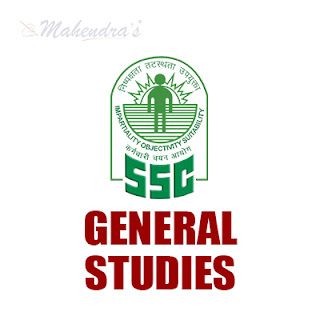
General Studies can be one of most scoring and marks gaining section in the SSC exam. This section doesn’t require any calculations and is thus the least time-consuming section, unlike other section. You can attempt this section very quickly and accurately. General Studies basically judge your basic general knowledge and how you are getting yourself updated time to time. It plays a vital role and benefits you to achieving the score required to cross the total cut off marks. Mahendra Guru providing you with an important General Studies quiz for SSC exam, it will help you to score if you regularly follow the contents of our website.
We also provide you General Studies Quiz for SSC examination based on the latest pattern.So, that you can practice on regular basis.
It will definitely help you to score good marks in the exam. It is the most important section for all the govt exam Insurance,SSC-MTS, CGL, CHSL, State Level and other Competitive exams.
(A) income of the consumers
(B) its own price
(C) taste of the consumers
(D) expectations of the consumers
Q.1. किसी वस्तु के माँग-वक्र के अनुसार गतिशीलता, किसमें आए परिवर्तन के कारण होती है?
(A) उपभोक्ताओं की आय
(B) उनके अपने मूल्य
(C) उपभोक्ताओं की रूचि
(D) उपभोक्ताओं की अपेक्षाएँ
Q.2. GNP calculation through Expenditure Method does not include -
(A) Gross Domestic Private Investments
(B) Net Foreign Investments
(C) Depreciation Expenditures
(D) Private Consumption Expenditure
Q.2. व्यय-विधि के माध्यम से जी.एन. पी. की गणना में क्या शामिल नहीं किया जाता?
(A) सकल घरेलू निजी निवेश
(B) निवल विदेशी निवेश
(C) मूल्यह्यास व्यय
(D) निजी उपभोग व्यय
Q.3. The Cobb-Douglas Production function Q = ALaK(1-a) is based on-
(A) increasing return to scale
(B) decreasing returns to scale
(C) constant returns to scale
(D) fluctuating returns to scale
Q.3. कॅाब -डगलस उत्पादन फलन Q = ALaK(1-a) किस पर आधारित है?
(A) मापक का विकासमान प्रतिफल
(B) मापक का ह्नासमान प्रतिफल
(C) मापक का स्थिर प्रतिफल
(D) मापक का अस्थिर प्रतिफल
Q.4. Find the odd one out of the following:
(A) Delhi Transport Corporation
(B) Indian Railways
(C) Kingfisher Airlines
(D) Reliance Industries Limited
Q.4. निम्न में विषम क्या है?
(A) दिल्ली परिवहन निगम
(B) भारतीय रेल
(C) किंग फिशर एअरलाइंस
(D) रिलायंस इंड्रस्ट्रीज लिमिटेड
Q.5. Monetary Policy in India is laid down and executed by-
(A) Union Government
(B) ASSOCHAM
(C) Reserve Bank of India
(D) FICCI
Q.5. भारत में मौद्रिक नीति किसके द्वारा बनाई और लागू की जाती है?
(A)केन्द्रीय सरकार
(B)एसोचैम
(C) भारतीय रिज़र्व बैंक
(D) फिक्की
Q.6. Which one of the following subjects is not available on the Union List?
(A) Census
(B) Banking
(C) Trade Union
(D) Foreign Loans
Q.6. निम्न में कौन-सा विषय, केंद्रीय सूची में नहीं है|
(A) जनगणना
(B)बैंकिंग
(C) मजदूर संगठन
(D) विदेशी ऋण
Q.7. The term "Closure" in Parliamentary terminology implies-
(A) the end of session of Parliament
(B) stoppage of debate on a motion
(C) end of a day’s proceedings
(D) None of the above
Q.7. संसदीय शब्दावली में ष्समापनष् से क्या आशय है|
(A) संसद के सत्र का अंत
(B) किसी प्रस्ताव की चर्चा पर रोक
(C) दैनदिन कार्यवाही का अंत
(D) उक्त में कोई नहीं
Q.8. Which of the following is not correctly matched?
(A) Article 14 - Equality before law
(B) Article 16 - Equal opportunities
(C) Article 17 - Abolition of titles
(D) Article 18 - Permission of military titles
Q.8. निम्न में कौन-सा जोड़ा अनुकूल नहीं है|
(A) अनुच्छेद 14 - विधि के अनुसार समानता
(B) अनुच्छेद 16 - समान अवसर
(C) अनुच्छेद 17 - उपाधियों का समापन
(D) अनुच्छेद 18 - सैनिक उपाधियों की अनुमति
Q.9. Which of the following President held office for two consecutive terms?
(A) Dr. S. Radhakrishnan
(B) Dr. Zakir Hussain
(C) Dr. Rajendra Prasad
(D) Both (A) and (C)
Q.9. निम्न में किस राष्ट्रपति ने लगातार दो बार राष्ट्रपति पद संभाला था|
(A) डॅा. एस. राधाकृष्णन
(B) डॅा. ज़ाकिर हुसैन
(C) डॅा. राजेन्द्र प्रसाद
(D) (A)तथा (C) दोनों
Q.10. Which Amendment Act reduced the voting age from 21 to 18?
(A) 42nd
(B) 44th
(C) 52nd
(D) 61st
Q.10. किस संशोधन अधिनियम से मतदान की आयु 21 वर्ष से घटाकर 18 वर्ष कर दी गई थी|
(A)42वां
(B)44वां
(C) 52वां
(D) 61वां
ANSWER KEY
Q.1. (B)
Q.2. (C) GNP Calculation through Expenditure method does not includes depreciation expenditures.
व्यय-विधि के माध्यम से जी.एन.पी. की गणना में मूल्हह्यास व्यय शामिल नहीं किया जाता है।
Q.3. (C) The cobb-Douglas Production function is based on constant returns to scale [Q =ALaK(1-a)] Y = Output, A = total factor productivity, K = Capital input, L = labour input, = output elasticities
कॅाब -डगलस उत्पादन फलन मापक का स्थिर प्रतिफल पर आधारित है। [Q =ALaK(1-a)] Q = उत्पादन, A = कुल कारक उत्पादकता, K = पूँजी निवेश, a = उत्पादन लोचदारिकता
Q.4. (D)
Q.5. (C) Monetary policy in India is laid down and executed by Reserve Bank of India.
भारत में मौद्रिक नीति, भारतीय रिज़र्व बैंक के द्वारा बनाई और लागू की जाती है।
Q.6. (C) Census, Banking, Foreign Loans are subjects of Union List and Trade Union Industrial and labour disputes are subjects of concurrent List of Indian Constitution.
जनगणना, बैंकिंग, विदेशी ऋण यह सभी संघ सूची के विषय है, तथा मजदूर संगठन औद्योगिक और श्रम विवादों के विषय को भारतीय संविधान की समवर्ती सूची में रखा गया है।
Q.7 (B) The term “closure” in Parliamentary terminology implies stoppage of debate on a motion.
संसदीय शब्दावली में ‘समापन’ से आशय किसी प्रस्ताव की चर्चा पर रोक होता है।
Q.8 (C) Article-17 Abolition of Untouchability
अनुच्छेद.17 अस्पृश्यता का निषेध।
Q.9 (C) Dr. Rajendra Prasad - 1950-1957-1962
Dr. S. Radhakrishnan - 1962-1967
Dr. Zakir Hussain - 1967-1969
डा. राजेन्द्र प्रसाद - 1950.1957.1962
डा. एस. राधाकृष्णन् - 1962.1967
डा. जाकिर हुसैन - 1967.1969
Q.10 (D) 61st Amendment Act (1988) reduced the voting age from 21 to 18.
61वें संविधान संशोधन (1988) से मतदान की आयु 21 वर्ष से घटाकर 18 वर्ष कर दी गयी थी।



